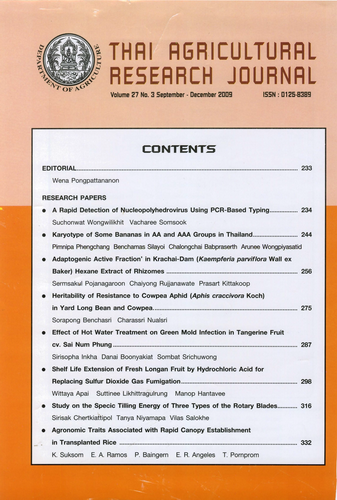Aronomic Traits Associated with Rapid Canopy Establishment in Transplanted Rice
DOI:
https://doi.org/10.14456/thaidoa-agres.2009.23Keywords:
plant canopy, canopy establishment, light reduction, weed competitionAbstract
Five popular improved varieties, 17 introgression lines and a donor parent, Oryza glaberrima, and 5 weedy-rice derived lines were evaluated for canopy establishment at the experimental field of the KU-Honda Project, Kasetsart University, Kamphaengsaen, Kakhon Pathom province during 2008 dry season. In addition, the possible contribution of plant height, tiller number, number of leaves and leaf area to rapid canopy establishment (RCE) was analyzed and determined. A wide variability in rate of canopy establishment among the 28 test varieties and lines was shown by significant differences in percent reduction of photosynthetically active radiation (PAR) within the canopy ant 30 and 35 days after transplanting (DAT). Four weedy-rice derived lines, WR1-38, WR1-55, WR1-61 and WR4-14, and 2 improved varieties, IR 64 and Suphan Buri 1, showed rapid canopy establishment with more than 50% PAR reduction starting at 30 days after transplanting. The improved variety Phitsanulok 2 and four introgression lines (SV2F7-06. SV2F7-07, SV2FT-12 and SV3F6-01) also showed rapid canopy establishment but only at 35 DAT. Tiller number, number of leaves and leaf area were positively correlated to light reduction within the canopy at 35 days after transplanting with r=0.62**, r=0.37** and r=0.51**, respectively. Plant height, on the other hand, did not contribute to light reduction within the canopy. Grain yield appeared to be independently inherited of RCE and can be combined in any variety. All these results indicate that rapid canopy establishment can be used as a selection index in the breeding of improved rice varieties for weed competitiveness.Downloads
Published
2009-12-31
How to Cite
Suksom, k, Ramos, E., Baingern, P., Angeles, E., & Pornprom, T. (2009). Aronomic Traits Associated with Rapid Canopy Establishment in Transplanted Rice. Thai Agricultural Research Journal, 27(3), 332. https://doi.org/10.14456/thaidoa-agres.2009.23
Issue
Section
Technical or research paper
License
Copyright (c) 2017 วารสารวิชาการเกษตร (Thai Agricultural Research Journal)

This work is licensed under a Creative Commons Attribution-NonCommercial-NoDerivatives 4.0 International License.
Thai Agricultural Research Journal



